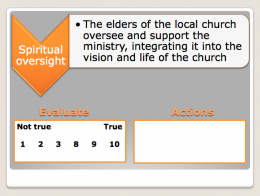 The value of grading
The value of grading
We ended the last posting discussing grading of the various statements. Recently I was leading a workshop in Zimbabwe on the Ministry Health Check. I asked participants to work in ministry teams but to score these statements as individuals before starting any discussion. I was surprised to find that some members on one team graded a particular statement very highly and another at a very low level. The resulting discussion revealed that this arose from there being little communication between team members on a daily basis; this then became the matter to consider for improvement.
An illustration
Returning to the statement above “The elders of the local church oversee and support the ministry, integrating it into the vision and life of the church” we were working with a Powerpoint presentation. This allows everyone to be focused on the same sentence.
When this statement was considered during a Health Check on one of the ministries in my local church which helps people who have been homeless to prepare for independent living there was general agreement that the elders’ oversight was good and supportive. But concern was expressed about the ‘integration into the vision and life of the church’.
Following a healthy discussion it was agreed that the ‘Action’ would be to meet with one of the elders, who oversees the Ministry, and to request that :
- Consideration should be given to preaching occasionally on matters which specifically relate to ministries among those who are poor and disadvantaged
- There should be more prayer and profiling of the ministry in the life of the church e.g. through prayer meetings and other ‘family evenings’
- Elders should be invited to visit the activities of the ministry (a residential unit) more frequently
- Elders from churches across the city should be invited to visit termly, particularly as some of the support workers on the ministry team were from other churches
This illustration shows how one statement is able to lead into productive discussion resulting in agreed Actions. These may strengthen the ministry and its integration into the community of the church and beyond. Recording of Actions will be discussed in the next post.
Time and space for discussion
From this illustration it may also be understood why I recommend that the review team should go to an undisturbed location for a couple of days to carry out the Health Check, a principle which Jesus himself pursued with his disciples. The process, if done thoroughly, needs sufficient time and an undisturbed atmosphere since there are over 30 such statements.
Some more statements
To help you expand your understanding of these statements here are two groups showing a few more examples. The first are a selection from the Indicators which have a ‘spiritual’ element, the second from the Indicators that would apply in the worlds of both Christian and secular aid agencies.
Group 1
• There is the certainty that God has spoken and commissioned the ministry – it is not just a ‘good idea’ or a response to a need
• There is a clearly defined vision with goals, objectives and expectations
• There is on-going prayer and an openness to the Spirit’s leading
• The team of workers are chosen because of a personal sense of call and appropriate gifting
Group 2
• The ministry has clearly defined objectives and activities with a structured schedule and budget
• There are short, medium and long term plans with a built in flexibility so as to be able to respond to changing circumstances
• Implementation with regular monitoring according to predetermined criteria ensures that the plans are being carried out effectively and appropriate changes are made
• After each significant stage of the ministry: review outcomes; encourage good practice; learn from mistakes
Next time we will look in more detail at the process and results.

